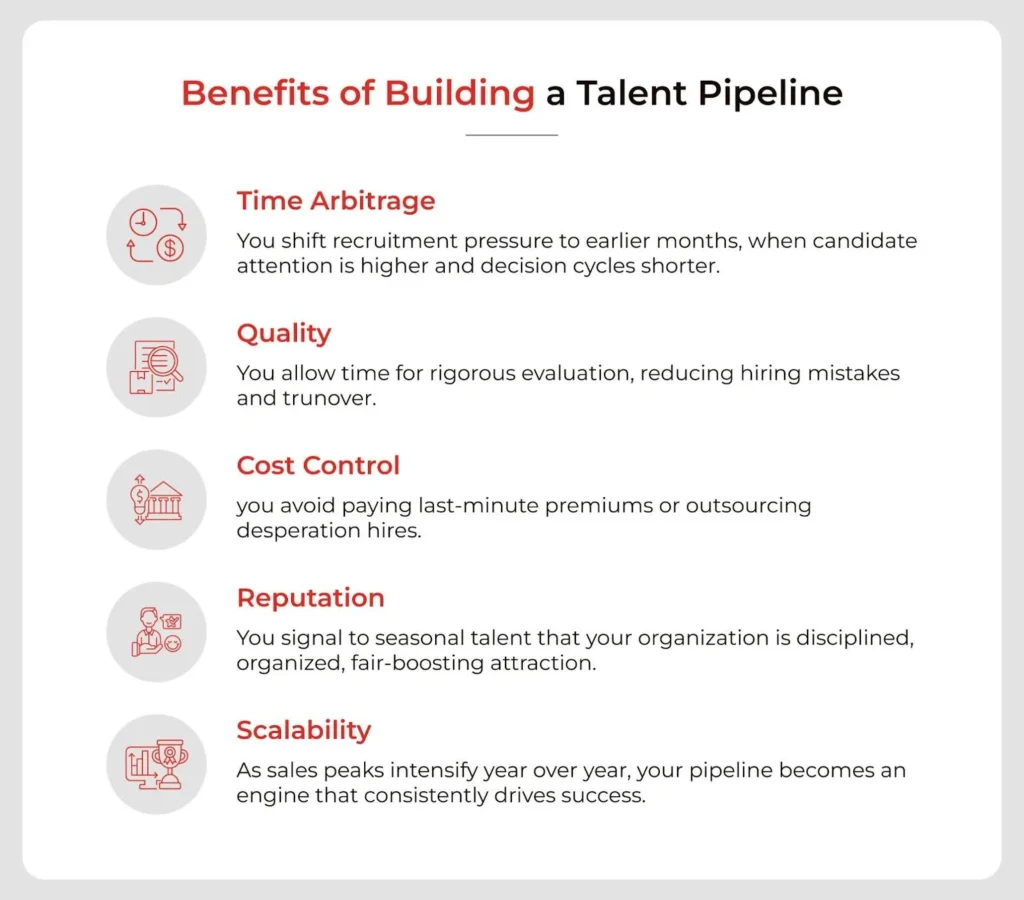The final quarter of the year is make-or-break for most businesses. As holiday shopping peaks and year-end projects accelerate, talent demand can surge by 20–40% across retail, logistics, and customer support functions. Yet every year, many organizations find themselves caught off guard, struggling to fill critical roles just as customer demand hits its highest. The result? Overworked teams, missed sales, and service gaps that ripple into the new year.
To avoid the scramble, companies need more than short-term hiring pushes. They need a strong, talent pipeline for holiday staffing — one that’s built before the season starts, not after the rush begins. This way, you’ll not only fill roles faster but also elevate your brand as a smart workforce planner.
Why a Talent Pipeline Beats Ad Hoc Holiday Hiring
When demand spikes, most organizations think in terms of headcount. But staffing isn’t a switch you can flip. It’s more like irrigation. Instead of turning the tap on once the field is dry, you prepare the channels long before the season arrives for optimal result. Holiday staffing follows the same logic.
The difference between companies that glide through the year-end surge and those that spiral into chaos often comes down to one quiet differentiator: how early and how deliberately they built their talent pipeline.
The mismatch of timing and supply
You’re competing for talent at the moment when most people are less open to change. Conventional recruiting models stretch months during peak windows. If you wait until November, you often face stretched recruiting timelines, limited talent pool, and higher costs.
Seasonal hiring demands are integral and the window closes fast.
Avoid expensive “rush hires”
When you rely solely on speed, you pay in turnover, onboarding errors, and mismatched skills. A well-tended pipeline gives you access to candidates who are already vetted, familiar, and ready, lowering risk and cost.
Strategic depth versus transactional fills
A pipeline brings you beyond just filling seats. It lets you scout potential returning seasonal workers, create trusted rosters, and integrate contingent staffing solutions into your broader workforce management playbook.
How to Create A Talent Pipeline (and Make It Real)
Here’s a methodical framework with tactics you can start implementing immediately.
1. Forecast demand with surgical precision
Use sales data, traffic patterns, promotion calendars, and your last 2–3 years of holiday performance. Map roles by priority (critical roles, supporting roles, floaters). Use workforce planning to predict where gaps may appear, then reverse engineer your hiring timeline around those.
Don’t just say “we’ll need more staff”; quantify how many, for which functions, when.
2. Begin sourcing months early
August is now prime time for holiday hiring. In that window, candidate availability is higher; you get more interest, time for assessment, and less competition.
Set up outreach campaigns, campus hiring (if applicable), alumni networks, referral programs, and seasonal talent pools. You can’t wait until peak demand; you pull supply forward.
3. Nurture a talent pool year-round
Maintain relationships with high-performers you used before, passive candidates in your domain, and contractors who’ve expressed openness. Keep them engaged with newsletters, check-ins, and short-term contracts.
If you build talent pool development as a habit, your holiday rush becomes your deployment phase instead of your starting gun.
4. Use a mix of staffing models
Leverage temporary staffing, contract-to-hire, and high-volume hiring where appropriate.
- Temp-to-hire gives you flexibility with evaluation before full commitment.
- Temporary workforce can support predictable, process-driven tasks.
- For high-volume roles (e.g. order processing, logistics during sales), parallel channels (gig platforms, staffing partners) help scale fast.
Mixing models adds redundancy, so you’re never over-leveraged on a single sourcing route.
5. Vet and onboard early
Don’t wait until the crunch to do your due diligence. Use screening, assessments, test tasks, and background checks in advance. Prepare onboarding playbooks, micro-training modules, and buddy systems.
When the holiday surge begins, your new hires should hit the floor ready and not in orientation limbo.
6. Retain top seasonal talent for future cycles
After the season, don’t discard your best performers. Invite them back, offer preferred status, keep them in your recruiting database.
Repeat cycles build loyalty and shorten time-to-fill in subsequent years. A returning seasonal employee is worth 3 new ones because you skip discovery and ramp time.
Also read: 5 Key Benefits of Project Staffing for Fast-Growing Teams
Integrating This Into Your Workforce Strategy (Without Adding Burden)
You may worry: this sounds like extra overhead. But pipelined holiday staffing can be streamlined into your workforce management architecture.
- Use your ATS/CRM to tag seasonal prospects.
- Build dashboards for candidate velocity through the pipeline.
- Sync with HRIS so you can convert temp-to-hire efficiently.
- Coordinate with finance early so budgets are pre-approved before Q4 peaks.
- Partner with a staffing agency for overflow, but only after you’ve mapped your internal pipeline strategy.
What You Gain (Beyond Just Filling Seats)

- Time arbitrage: You shift recruitment pressure to earlier months, when candidate attention is higher and decision cycles shorter.
- Quality: You allow time for rigorous evaluation, reducing hiring mistakes and turnover.
- Cost control: You avoid paying last-minute premiums or outsourcing desperation hires.
- Reputation: You signal to seasonal talent that your organization is disciplined, organized, fair and thus boost reputation.
- Scalability: As sales peaks intensify year over year, your pipeline becomes an engine that consistently drives you to success.
Final Thoughts: Get Started Now (and Scale Over Time)
If you take away one insight: holiday staffing is a capability you must build. Start small this year, even piloting in one department or region, but design with intent so you can scale.
- In your next internal planning cycle, embed contingent staffing solutions as part of your operating budget.
- Assign one person or team to own the seasonal talent pipeline; treat it as a product you iterate on.
- After the season, treat every metric and experience as inputs for the next cycle. Track: time-to-fill, cost per hire, retention, performance, referral yield.
Over successive cycles, you’ll evolve that pipeline into a strategic advantage, one that lets you walk into the holiday season knowing: we’re ready.
At SPECTRAFORCE, we help organizations turn seasonal chaos into structured opportunity. Our workforce management and contingent staffing solutions are built for speed, scale, and predictability.
Whether you’re preparing for high-volume hiring or optimizing your seasonal hiring strategy across multiple sites, SPECTRAFORCE gives you the data, the process, and the people to execute flawlessly.
Start planning your next peak season with confidence. Explore our staffing services.
FAQs
Seasonal workforce planning is important for the holiday period because it helps companies anticipate demand spikes and avoid last-minute hiring chaos. By preparing early, HR leaders can align holiday staffing needs with operational goals, ensuring productivity, continuity, and service quality even during peak load. It also enables better cost management, improved scheduling, and higher retention among temporary employees.
Companies should start holiday staffing at least two to three months before the seasonal peak. Starting early allows recruiters to build a talent pipeline, screen candidates thoroughly, and conduct training before operations surge. Many high-performing organizations begin sourcing in August or September, giving them the advantage of greater candidate availability and lower competition for top seasonal talent.
The best ways to build a seasonal talent pipeline include maintaining contact with past high-performing seasonal hires, using temporary staffing partners, running early referral campaigns, and developing a database of pre-vetted talent. Regular engagement, through newsletters, check-ins, or micro-contracts, keeps your seasonal talent pool warm and ready for quick deployment during the next hiring cycle.
Staffing agencies can speed up holiday hiring by using pre-qualified talent pools, digital assessments, and data-driven matching tools. Agencies with advanced contingent staffing solutions often embed recruiters within client teams, allowing faster turnaround on job requisitions. They also use analytics to forecast demand and reduce hiring delays, making high-volume hiring more predictable and efficient.
Companies retain top seasonal employees for future needs by offering continuity, such as early rehire programs, loyalty bonuses, and training opportunities that lead to long-term roles. Retention improves when organizations treat seasonal workers as part of their core team, maintaining transparent communication and fair compensation. A well-structured talent pipeline strategy ensures that high-performing temporary workers return year after year, reducing ramp-up time and improving quality.



